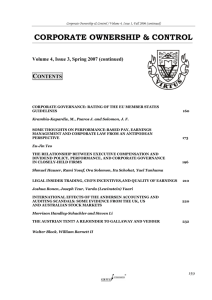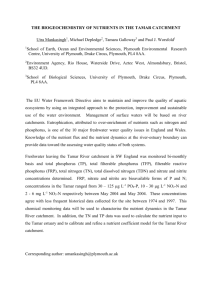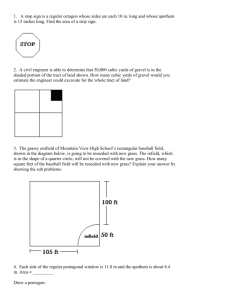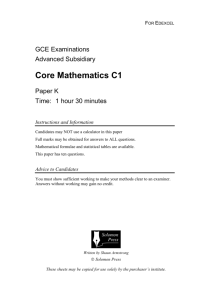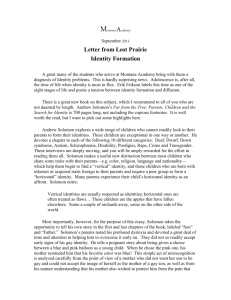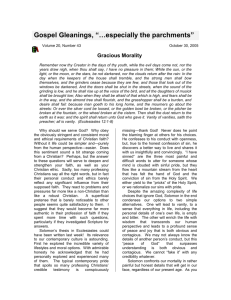Criminal Law Exam Sp 94
advertisement
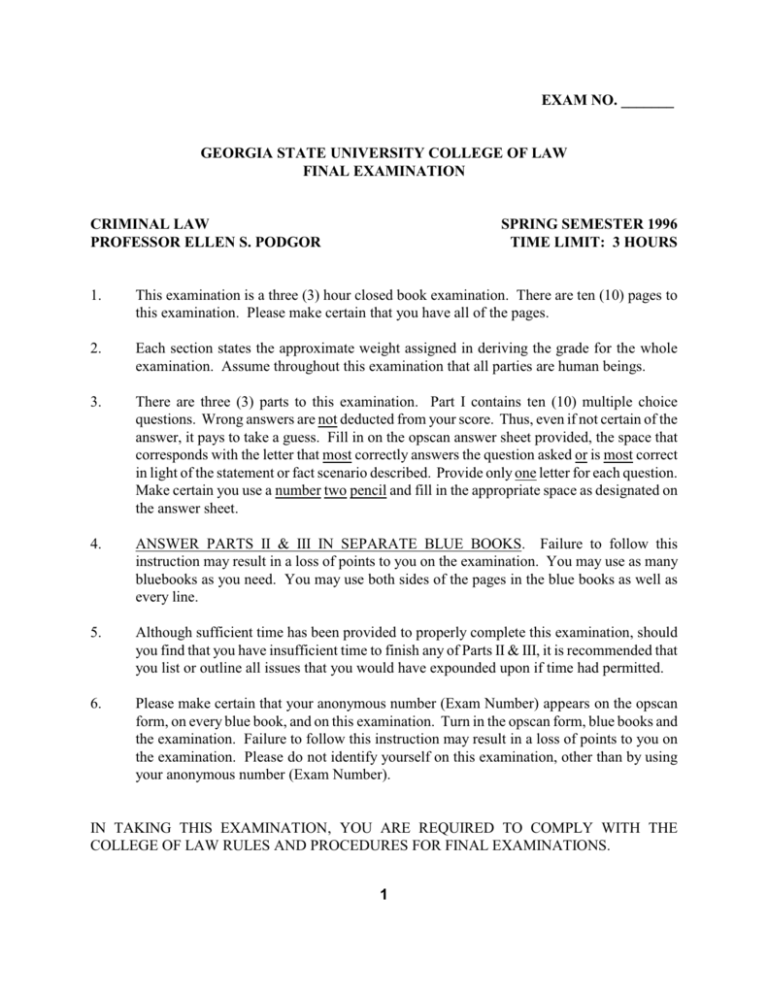
EXAM NO. _______ GEORGIA STATE UNIVERSITY COLLEGE OF LAW FINAL EXAMINATION CRIMINAL LAW PROFESSOR ELLEN S. PODGOR SPRING SEMESTER 1996 TIME LIMIT: 3 HOURS 1. This examination is a three (3) hour closed book examination. There are ten (10) pages to this examination. Please make certain that you have all of the pages. 2. Each section states the approximate weight assigned in deriving the grade for the whole examination. Assume throughout this examination that all parties are human beings. 3. There are three (3) parts to this examination. Part I contains ten (10) multiple choice questions. Wrong answers are not deducted from your score. Thus, even if not certain of the answer, it pays to take a guess. Fill in on the opscan answer sheet provided, the space that corresponds with the letter that most correctly answers the question asked or is most correct in light of the statement or fact scenario described. Provide only one letter for each question. Make certain you use a number two pencil and fill in the appropriate space as designated on the answer sheet. 4. ANSWER PARTS II & III IN SEPARATE BLUE BOOKS. Failure to follow this instruction may result in a loss of points to you on the examination. You may use as many bluebooks as you need. You may use both sides of the pages in the blue books as well as every line. 5. Although sufficient time has been provided to properly complete this examination, should you find that you have insufficient time to finish any of Parts II & III, it is recommended that you list or outline all issues that you would have expounded upon if time had permitted. 6. Please make certain that your anonymous number (Exam Number) appears on the opscan form, on every blue book, and on this examination. Turn in the opscan form, blue books and the examination. Failure to follow this instruction may result in a loss of points to you on the examination. Please do not identify yourself on this examination, other than by using your anonymous number (Exam Number). IN TAKING THIS EXAMINATION, YOU ARE REQUIRED TO COMPLY WITH THE COLLEGE OF LAW RULES AND PROCEDURES FOR FINAL EXAMINATIONS. 1 PART I: APPROXIMATELY 20% OF GRADE (ESTIMATED TIME: TWENTY (20) MINUTES) On the opscan sheet provided fill in the space that corresponds with the letter that most correctly answers the question asked or is most correct in light of the statement or fact scenario described. Provide only one letter for each question. Make certain you use a number two pencil and fill in the appropriate space as designated on the answer sheet. 1. Gemma Yarn does not like Axel Flatt and wishes he were dead. For ten days Gemma Yarn thinks about killing Axel Flatt. Which of the following is most correct? A. Gemma Yarn can be punished for wishing that Axel Flatt were dead. B. Gemma Yarn can be punished for intending to kill Axel Flatt. C. Gemma Yarn cannot be punished for intending to kill Axel Flatt because she has not thought about killing him for a sufficient period of time. D. Gemma Yarn cannot be punished for wishing that Axel Flatt was dead, or for thinking about killing Axel Flatt. 2. Caldwell Curcio is convicted, after a trial by jury, of a state statute that makes it a criminal offense for a person to “be addicted to the use of narcotics.” Caldwell Curcio was arrested on a corner adjoining a local law school and a police station. At the time of her arrest, Caldwell Curcio had needle marks on her arm. She readily admitted to the arresting police officer, after being given proper Miranda warnings, that she was addicted to narcotics. Which of the following is most correct? A. Caldwell Curcio’s conviction should be reversed in that the state statute is unconstitutional. B. Caldwell Curcio’s conviction should be reversed in that there is insufficient evidence to support the conviction. C. Caldwell Curcio’s conviction should be affirmed in that there was sufficient evidence to support the conviction. D. Caldwell Curcio’s conviction should be affirmed in that she was arrested in a public place. E. Both C & D. 2 3. Solomon Poodell fails to file his tax return on April 15th. He also fails to file for an extension. Solomon Poodell has taxes that are due and owing. Solomon Poodell does not file his income tax return because he thinks the tax laws in the United States are unconstitutional. Which of the following is most correct? A. Solomon Poodell cannot be found criminally liable for failing to file his income tax return because he has not acted willfully. B. Solomon Poodell cannot be found criminally liable for failing to file his income tax return in that he failed to act and criminality requires an actus reus. C. Solomon Poodell can be found criminally liable for failing to file his income tax return in that an omission, where there is a contractual obligation, serves as an exception to the rule that an act is always required. D. Solomon Poodell can be found criminally liable for failing to file his income tax return in that an omission, where there is a statutory duty to act, serves as an exception to the rule that an act is always required. 4. Maddy Madison is charged with the crime of driving a truck without consent of the owner. Maddy Madison was driving along a highway when a nearby vehicle swerved in her direction. To avoid being hit by this vehicle, Maddy Madison drove her automobile off the highway into a marsh. Maddy Madison’s vehicle became stuck in the marsh. Maddy Madison observed a tow truck two hundred feet away. She went to the house where the tow truck was, and knocked on the door. No one answered. She decided to take the tow truck to get her vehicle out of the marsh. Maddy Madison had a telephone in her car. Which of the following is most correct? A. Maddy Madison has a legitimate defense of necessity. B. Maddy Madison has a legitimate defense of duress. C. Maddy Madison has a legitimate defense of both necessity and duress. D. Maddy Madison does not have a legitimate defense of necessity in that there are effective legal alternatives for averting the harm. E. Maddy Madison does not have a legitimate defense of duress because she has not committed a homicide. 3 5. John Marshall is charged in a common law jurisdiction with the crime of assault with intent to rape. John Marshall wishes to introduce evidence at trial that he lacked the necessary intent to rape because he was too intoxicated to know what he was doing. Which of the following is most correct? A. The court should permit John Marshall to present this evidence since intoxication can be relevant if the degree of inebriation has reached that point where John Marshall could not have formed the required intent to commit the crime. B. The court should only permit John Marshall to present this evidence if his evidence is that this was involuntary intoxication. C. The court should not permit John Marshall to present this evidence in that intoxication is never a legitimate defense to a crime. 6. “A person is not responsible for criminal conduct if at the time of such conduct as a result of mental disease or defect he lacks substantial capacity either to appreciate the criminality [wrongfulness] of his conduct or to conform his conduct to the requirements of law.” Which of the following is most correct? A. This is the insanity test known as the Durham Test. B. This is the insanity test known as the M’Naghten Test. C. This is the insanity test known as the Irresistible Impulse Test. D. This is the insanity test known as the American Law Institute (Model Penal Code) Test. E. None of the above are correct. 7. It is improper for a state to pass a law that permits a jury to find a defendant guilty but mentally ill. Is this statement true or false? A. True B. False 4 8. Rusty Kaminshine does not like his cousin Tamar Podgor. Rusty Kaminshine decides that he will kill his cousin, Tamar Podgor, by adding poison to her food that night. While driving home from work, Rusty Kaminshine accidentally hits another automobile. The car hit by Rusty Kaminshine catches on fire and explodes. Unbeknownst to Rusty Kaminshine, Tamar Podgor was a passenger in this automobile. Tamar Podgor dies as a result of the automobile exploding. Rusty Kaminshine was not at fault in this automobile accident and was not in violation of any traffic offenses. Which of the following is most correct? A. Rusty Kaminshine can be convicted of the homicide of Tamar Podgor in that he had the intent to kill Tamar Podgor. B. Rusty Kaminshine cannot be convicted of the homicide of Tamar Podgor in that he did not intend to kill Tamar Podgor in this automobile accident. 9. John Marshall and Tamar Poodell are both married, but not to each other. The state in which John Marshall and Tamar Poodell live prohibits adultery. John Marshall and Tamar Poodell commit adulterous acts with each other. The state charges John Marshall and Tamar Poodell with conspiracy to commit adultery. Which of the following is most correct? A. The state will have problems with this prosecution because of the independent felony rule. B. The state will have problems with this prosecution because of Wharton’s Rule. C. The state will have problems with this prosecution because adultery is not an inherently dangerous felony. D. The state will have problems with this prosecution because John Marshall and Tamar Poodell did not have the specific intent to commit adultery. E. The state should have no problems in prosecuting this case. 5 10. Charlotte Hartfield is an attorney representing Kip Emanuel, who has been charged with homicide. Charlotte Hartfield raises a defense of insanity. In determining whether Kip Emanuel is insane, the fact-finder must decide: I. Whether the defendant lacks the capacity to understand the nature and object of the proceedings against him or her. II. Whether the defendant can assist in his or her own defense. III. Whether the defendant was insane at the time of the crime. IV. Whether the defendant is presently insane. Which of the following is most correct? A. Only I B. Only III C. Only IV D. Only III & IV E. I, II , III, & IV. 6 PART II: APPROXIMATELY 40% OF GRADE (ESTIMATED TIME: SEVENTY-FIVE (75) MINUTES) Tamar Poodell has been charged with the following: Count I- First Degree Felony Murder (18 S.D.C. § 101(b)); Count II - Recklessly Endangering Another Person (18 S.D.C. § 200); and Count III- Violation of the Discharge Act (18 S.D.C.§ 310). You have been appointed by the court to represent Tamar in her upcoming trial. In your interviews with Tamar, you receive the following information from your client: Moses Hound, an environmental protection agency investigator, came to Tamar Poodell’s place of employment on April 1, 1996. Tamar Poodell works at a dog biscuit factory where she stands on an assembly line with others, and places dog biscuits in boxes to be shipped to customers throughout the United States. Moses Hound approached Tamar Poodell, while she was surrounded on either side by other workers who, like herself, were placing dog biscuits in boxes. Moses Hound loudly proclaimed, in front of Tamar’s coworkers, that Tamar Poodell was in violation of the discharge act. Moses Hound stated that Tamar Poodell had been seen using the river behind her home as a bathroom facility. Tamar was extremely embarrassed by what Moses Hound was saying. She screamed out, “how was I to know that this was against the law, I’m going to kill you.” She instantly picked up a nearby knife and proceeded to stab Moses Hound ten times. Moses Hound was pronounced dead at the scene. In addition to receiving information from your client, you also meet with Dr. Nalla Wermiel, who informs you that he believes Tamar Poodell is mentally retarded. EXPLAIN IN DETAIL WHAT, IF ANY, LEGAL ARGUMENTS AND DEFENSES YOU CAN RAISE IN DEFENDING TAMAR POODELL AND WHETHER YOU THINK THESE ARGUMENTS WILL BE SUCCESSFUL. INCLUDE IN YOUR DISCUSSION ARGUMENTS ON WHETHER THE COURT SHOULD GIVE A MENS REA INSTUCTION FOR COURT IIIVIOLATION OF THE DISCHARGE ACT, AND IF SO, WHAT THAT INSTUCTION SHOULD INCLUDE. Some of the statutes from this jurisdiction are attached. Your memo need not, however, be limited to these statutes. Note -- Assume that all parties in this question are human beings. (If your answer is contingent upon information not provided, explain what that information is and how it would affect your answer.) 7 Some of the statutes in this jurisdiction are: 18 S.D.C. § 101. First Degree Murder a. First degree murder is the intentional and unlawful killing of a human being with malice and with premeditation and deliberation; or b. All murder which is committed in the perpetration of a felony. 18 S.D.C. § 102. Second Degree Murder All other kinds of murder shall be murder of the second degree. 18 S.D.C. § 103. Voluntary Manslaughter Voluntary Manslaughter is an intentional homicide, if the act is done in a sudden heat of passion, caused by adequate provocation, before there has been a reasonable opportunity for the passion to cool. 18 S.D.C. § 200 Recklessly Endangering Another Person A person commits the crime of recklessly endangering another person if he or she recklessly engages in conduct which places or may place another person in danger of death or serious bodily injury. Recklessness and danger shall be presumed where a person knowingly points a firearm at or in the direction of another, whether or not the actor believed the firearm to be loaded. 18 S.D.C. § 310. Violation of the Discharge Act Whoever willfully discharges an improper substance into any waterway is guilty of a felony and shall be fined not more than ten thousand ($ 10,000) dollars or imprisoned not more than two (2) years, or both. 8 PART III: APPROXIMATELY 40% OF GRADE (ESTIMATED TIME: EIGHTY-FIVE (85) MINUTES) Solomon Poodell, has been found guilty after a trial by jury of the following: Count One - Robbery; Count Two - Conspiracy to Commit Robbery; Count Three - Theft of an Automobile; Count Four - Attempted Burglary of a Dwelling. The following is a summary of the evidence presented at Solomon Poodell's trial: Pippin Bross, under a grant of immunity in exchange for his testimony, testified that on March 31, 1995, he and Solomon Poodell decided that they would play an April Fool’s joke on their friends who worked at the Stillstanding National Bank. They decided that on April 1, 1995 they would enter the bank with water pistols and demand the money from the teller. They would then squirt water at all the tellers. Pippin testified that on the morning of April 1st he and Solomon entered the Stillstanding National Bank with their water pistols. Solomon stood by the door of the bank while Pippin approached a teller who did not know him. Pippin testified that he demanded that the teller, Hanna Morgan, turn over the money in her drawer to him. Teller Hanna Morgan testified that she had never seen a gun before and believed that Pippin was really robbing the bank. She immediately handed the money in her drawer to Pippin. Pippin testified that he was overwhelmed at suddenly holding thousands of dollars. Pippin stated that he took the money, ran out of the bank and hot wired a car, not his own, that was parked outside. Pippin stated that he drove off in this vehicle. He stated that he did not have the owner’s permission to take this automobile. Solomon testified that he was aghast at what Pippin had just done, and ran out of the bank after him. He said that by the time he had exited the bank, Pippin had already driven off in the unknown vehicle. Solomon testified that he immediately took the local bus to Pippin’s home to try and find him. He knocked on the door, rang the doorbell, but no one answered. He thought for sure Pippin would be inside. Solomon testified that he then proceeded to try and open a basement window, in order to get into the house. Being unsuccessful in opening the window, he gave up and went home. Two hours later the police arrested Solomon Poodell and charged him with robbery of the Stillstanding National Bank, conspiracy to commit robbery, theft of an automobile, and attempted burglary of the dwelling house of Pippin. At the conclusion of the State's case, defendant Solomon Poodell made a Motion to Dismiss his case arguing that as a matter of law, this case should not be submitted to the jury. The court denied this 9 motion. At the end of the trial, the court instructed the jury. Solomon Poodell’s attorney objected to an instruction by the court that stated: The defendant is legally accountable for the crime of robbery if you find that he aided, abetted, or counseled in the commission of the crime of robbery. Solomon Poodell’s attorney argued, unsuccessfully, that there was insufficient evidence of aiding and abetting to support the giving of this instruction to the jury. WRITE THE APPELLATE COURT'S OPINION THAT INCLUDES REFERENCE AND DISCUSSION TO ALL CRIMINAL LAW ISSUES THAT YOU FEEL SOLOMON POODELL MIGHT HAVE RAISED ON APPEAL. (Obviously, it is not necessary to discuss issues of criminal procedure that were not covered this semester.) MAKE CERTAIN THAT YOUR OPINION EXPLAINS IN DETAIL THE RATIONALE FOR YOUR RULING AS TO EACH ISSUE. ASSUME THAT DEFENDANT SOLOMON POODELL MADE ALL NECESSARY MOTIONS TO PROPERLY PRESERVE THE ISSUES PRESENTED IN THIS APPEAL. ASSUME THAT YOU ARE IN A NEW STATE WITHIN THE UNITED STATES THAT HAS NO PRECEDENT, BUT ACCEPTS THE PRECEDENT OF ANY OTHER PRESENTLY EXISTING JURISDICTION. BE CERTAIN AS JUDGE THAT YOU PROVIDE THE POLICY RATIONALES FOR ACCEPTING AND REJECTING RULES AND PRECEDENT IN WHICH COURTS IN THE UNITED STATES MAY BE SPLIT. Note -- Assume that all parties in this question are human beings. (If your decision is contingent upon information not provided, explain what that information is and how it would affect your decision.) 10
